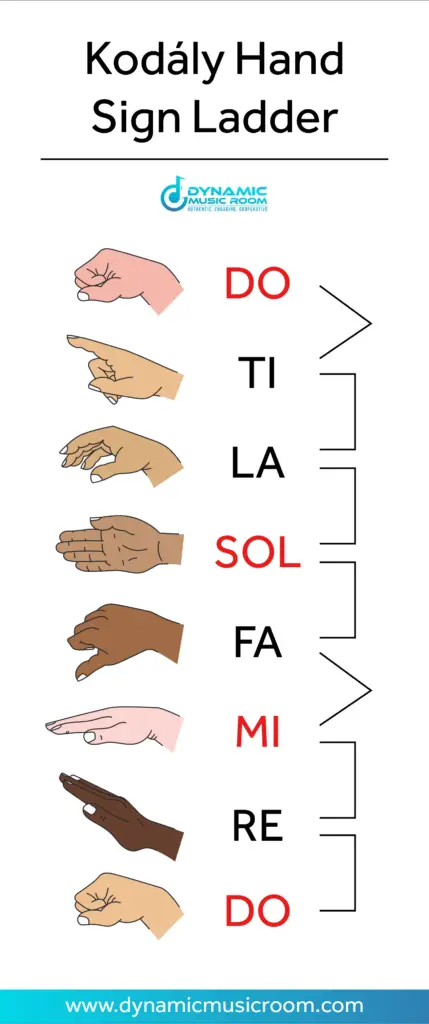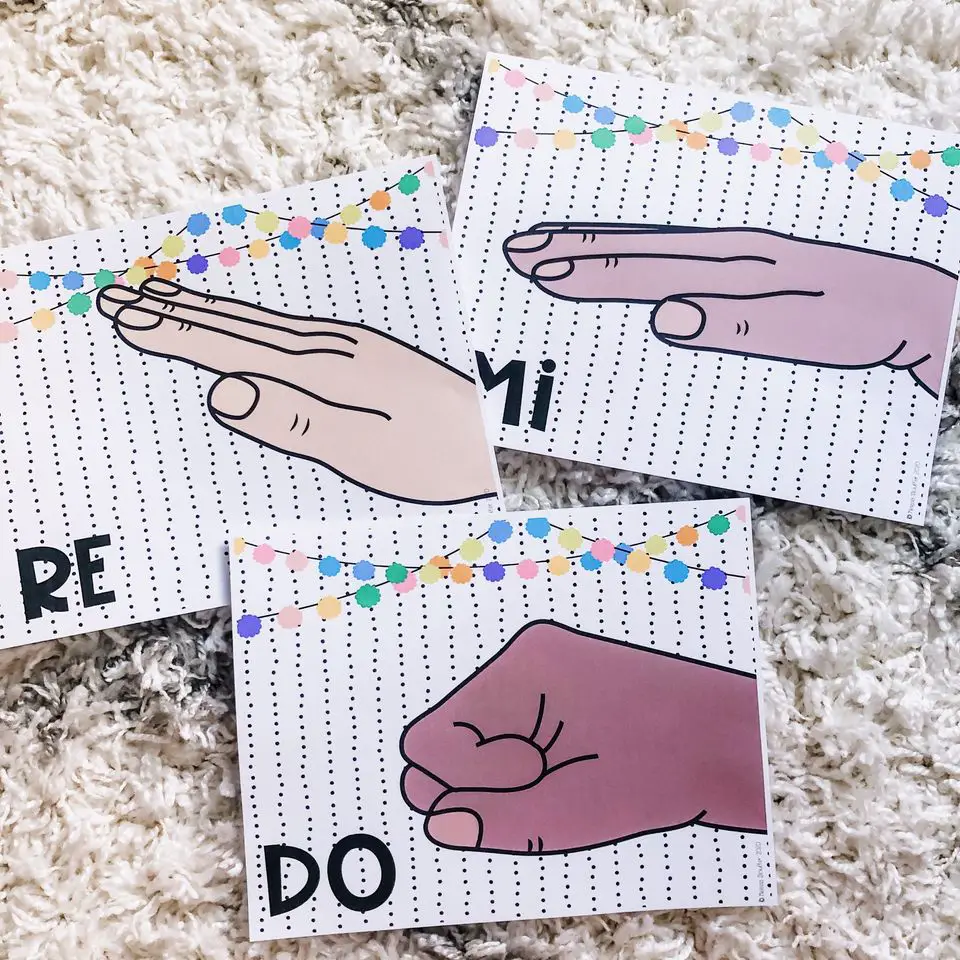Do you want new ways to practice Kodaly hand signs and solfege?
Are you looking for powerful visuals for teaching solfege to your students?
As a music teacher for over 10 years, I know how critical using visuals to help teach is.
I can’t tell you how many times I struggled to get a concept across when I introduced a visual, and boom!
The students got it.
One of the must-have visuals to check out is the Kodaly hand sign ladder.
Kodaly hand sign ladders are visual representations of pitches with hand sign reminders for how to sign. They’re modeled on the traditional Curwen hand signs, and the steps of the ladder show the pitch relationship.
Check out the rest of the article for examples and more information.
Table of Contents
What Does A Kodaly Hand Sign Ladder Need?
Unlike a simple solfege ladder (check out the article for more details), a Kodaly ladder needs two important parts.
The Solfege
First, it needs to include the solfege syllables and their placement in relation to each other.
Often, there will be some way to show how whole steps and half steps are different.
This may be by showing a full bracket for whole notes and a pointed bracket for half notes.
Sometimes the ladders show this by placing half steps closer together than whole steps.
Regardless, the ladder needs to show from high to low how the pitches go.
The Hand Signs
The other thing it needs to include is the hand signs themselves.
There are a ton of great options out there to buy or download (see a few of my favorites in the section below).
I even include one I made for you for FREE (just include a link back to the Dynamic Music Room and this article if you can).
Variations in the hand sign shapes occur as you’d expect with any tool, but they mostly contain the same shape.
Some of the shapes even hint at their pitch tendencies.
For example, Fa points down to Mi, and the fourth scale degree typically resolves to the third.
Hand signs are useful tools for music teachers because it connects different learning styles with the sound concept of pitch relationships.
That’s fancy talk for: it helps students hear the music inside better.

Mistaken Ownership Of The Hand Signs
The hand signs shapes weren’t invented by Kodaly himself, though many people wrongfully assume this to be true.
He did make them much more prevalent through the application of Kodaly-inspired teaching.
The hand signs were first developed by John Curwen in the middle 1800s.
He was an English minister and supporter of using sol-fa or solfege to teach people how to sing and read music.
Curwen developed his hand signs as a physical and visual way to connect to the aural art of singing.
When Kodaly was developing his approach with the help of his graduate students, they adopted the use of Curwen hand signs.
Because of the popularity of his method, Kodaly ended up with the credit of the hand signs.
Regardless, the hand signs are in common use by music teachers around the world even today.
Are Kodaly Ladders Needed?
I hate the word: needed.
I guess not; it’s possible to teach without it, but it’s much easier when you have it.
I prefer to use the ladder with removable hand signs.
This way, the students can focus on the ones they know.
When you remove the hand signs, it also serves to emphasize the spaces between the pitches.
Then again, if all you did was post the ladder in your room and leave it there, you probably don’t need it.
But there are some great ways to use it!
Check out these brief ways to use Kodaly ladders:
- Mystery song. Point at the solfege and have students guess the song.
- Interval naming. Use the spaces to help the students sing the difference between steps, skips, and leaps.
- Quizzing. Remove the hand signs to test your students and see if they’re retaining information.
- Decoding. Sing a melody and have the student or students tap out what you sang.
There’s so much more, but this should give you a little idea of how useful it is.
Favorite Kodaly Ladders And Hand Sign Visuals
I offered one of my own to share for free, but it may not be exactly what you’re looking for.
Don’t worry; you’re not hurting my feelings!
So I decided to include a few more examples of ones I’ve used from different sources.
Some are the ladders, and some are more like notecards.
Regardless, the quality is great, and the price is often low, perfect for the music teacher on a budget (which is everyone, right?).
Disclaimer: Some links may be affiliate in nature, which means we earn a small commission if you click and buy at no extra cost to you. Really, it’s a win-win for you and us, so thanks in advance!

These are some awesome cards by a dear friend of mine and another music blogger, Melissa Stouffer.
Her stuff is over on Teacher Pay Teacher and always fun and quality (plus, it’s affordable!).
I don’t make any money on this one; I just believe in it a lot, so go check it out!
Final Thoughts
I hope you find this information and example of a Kodaly hand sign ladder helpful.
These are great ways to show students the relative connections between pitches while also reminding them how those tricky hand signs go.
If you liked this post, you might also enjoy checking out my FREE Kodaly rhythm chart.


